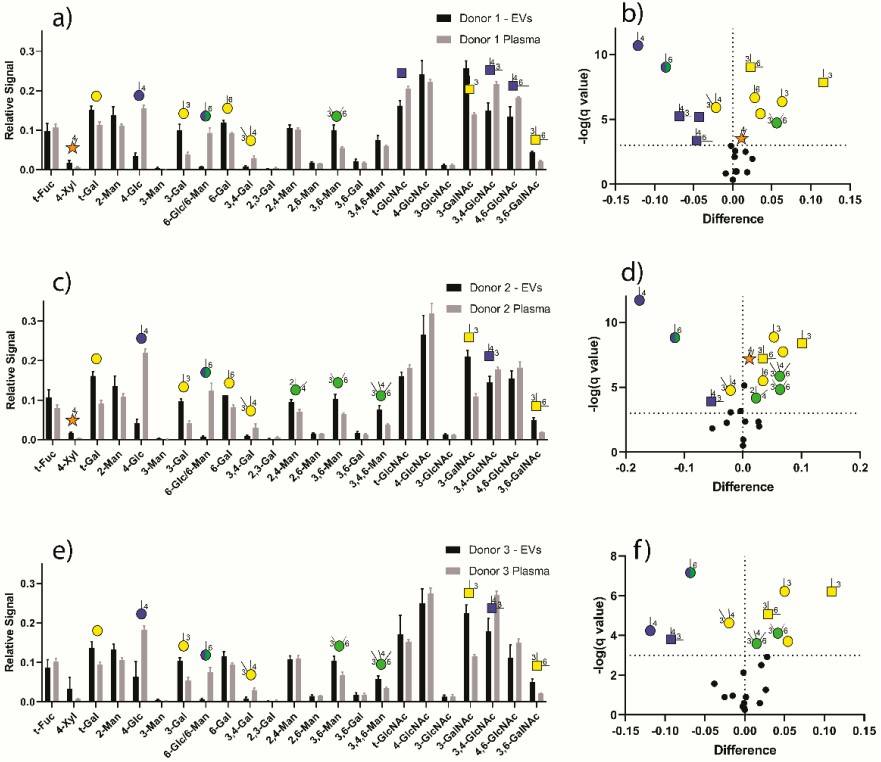Gas Chromatography-Mass Spectrometry (GC-MS) for Glycan Analysis
Creative Biolabs is a fully equipped laboratory facility with specialized equipment for glycan analysis. With Ph.D. level scientists and extensive experience in applying gas chromatography-mass spectrometry (GC-MS) for analysis, we are happy to share our knowledge in this field to facilitate our customers’ project development.
GC-MS Technology for Glycan Analysis
Protein glycosylation is one of the major post-translational modifications (PTMs), which occurs in about 50% of proteins in humans. Synthesized without a template, glycans are key players in various significant intra- and extracellular events. Most glycans have complex structures and are comprised of a large number of monosaccharides linked by glycosidic bonds. The structure complexity is the result of various monosaccharides being attached to the protein via different linkages (N-linkage or O-linkage), linkage positions and branching.
Many pathological conditions affect gene expression, which can in turn deregulate the abundance of glycans. Unique aberrant glycans are often present in trace quantities within complex biological samples, making their detection difficult and sometimes stochastic. However, GC-MS, one of the oldest forms of mass spectrometry, can routinely be used to detect the collection of branch-point and linkage-specific monosaccharides present in complex samples. Mass spectra acquired by this hyphenated technique offers more structure-related information, and thus, monosaccharides can be characterized by GC-MS. In order to use GC-MS, hydrophilic monosaccharides need to be derived by trimethylsilylation or acetylation. GC-MS analyses of derivatized monosaccharides usually allow for an excellent chromatographic resolution for monosaccharides, thus providing structural information for identification.
GC-MS for Glycan Analysis Service at Creative Biolabs
Creative Biolabs provides comprehensive GC-MS for glycan analysis services based on top-class scientific experts and substantial experience. Our instrument can detect pM amount of samples and is primarily used for monosaccharide and linkage analysis of glycans. Complementary to traditional glycomics techniques, GC-MS involves the collection and condensation of each constituent glycan in a sample into a single independent analytical signal, which provides detailed structural and quantitative information about changes to the glycome as a whole.
Highlights
-
Reliability and information security
-
Top-rated customer experience
-
High flexibility and cost-effectiveness
-
Tailored research & services
With proven experience in glycoscience, Creative Biolabs is an ideal company to entrust with your business. Our continually expanding range of instruments including GC-MS allows us to offer a wide range of glycan analysis services. We have perfected our technical pipelines of GC-MS for glycan analysis. For more detailed information, please feel free to contact us or directly send us an inquiry.
Published data
Extracellular vesicles (EVs) are nanoscale cell-secreted particles that can deliver bioactive molecules and thus participate in intercellular communication, which are easily obtained in plasma. EVs generally contain a variety of biomolecules, such as glycans. Glycans play key roles in physiological and pathological processes, and some glycans in plasma are associated with different disease states. In this study, the authors used glycan node analysis (GNA) to evaluate the differences in the expression of multiple sugars in plasma-derived EVs. GNA is a medium-throughput carbohydrate analysis method and a molecular bottom-up GC-MS-based glycan analysis method. This method can be directly applied to complex biological matrices, covering all major glycan categories and capturing specific glycan features such as α2-6-sialylation and core fucosylation. First, the authors used a size exclusion chromatography column to separate EVs from plasma, and small particles and lipoproteins in the sample were removed by column interaction. Then, GNA was used to analyze the various glycan information within EVs. EVs are associated with a variety of diseases, and detecting various glycans in EVs by GNA may become an effective, economical, and efficient method in the future.
 Fig.1 GNA profiles in plasma samples.1
Fig.1 GNA profiles in plasma samples.1
FAQs
Q1: What are the main advantages of using GC-MS compared to other glycan analysis techniques?
A1: GC-MS offers some unique advantages for glycan analysis:
-
High sensitivity: It detects glycans at picomolar (pM) concentrations.
-
Structural information: GC-MS provides detailed structural information about glycans, including linkage and branch point analysis.
-
Resolution: Excellent chromatographic resolution for derivatized glycans.
-
Quantitative analysis: It allows for quantitative analysis of changes in the glycome.
Q2: How do you prepare samples for glycan GC-MS analysis?
A2: Sample preparation for GC-MS involves several key steps:
-
Glycan release: Glycans are released from proteins.
-
Purification: Glycans are purified to remove proteins, peptides, and other contaminants.
-
Hydrolysis: Glycans are hydrolyzed into monosaccharides or oligosaccharides by acid hydrolysis or enzymatic treatment.
-
Derivatization: The hydrolyzed sugars are then derivatized by trisilylation or acetylation to make them suitable for GC-MS analysis.
-
Injection: The derivatized sample is then introduced into the GC-MS system to quickly and accurately identify and quantify the monosaccharide units in the glycans and how they are linked, thereby revealing the structure and properties of the glycans.
Q3: What types of glycans can be analyzed using GC-MS?
A3: GC-MS can analyze various types of glycans, such as N-linked glycans, O-linked glycans, oligosaccharides, etc. In GC-MS analysis, the sample mixture is first separated into individual components by gas chromatography, and then the relative molecular weight and structural information of these components are determined using mass spectrometry.
Customer Review
Professionalism And Rigor of Analysis Details
"The GC-MS glycan analysis service provided by Creative Biolabs is excellent. The experimental results are accurate and reproducible, and every detail of the service process shows a high degree of professionalism and rigor."
High Detection Sensitivity
"Creative Biolabs has first-class GC-MS equipment with detection sensitivity reaching pM level, which is crucial for the analysis of trace biological samples in our research projects."
Reference
-
Walker, Sierra A., et al. "Glycan node analysis of plasma-derived extracellular vesicles." Cells 9.9 (2020): 1946. Distributed under Open Access license CC BY 4.0, without modification.
For Research Use Only.
Related Services

 Fig.1 GNA profiles in plasma samples.1
Fig.1 GNA profiles in plasma samples.1

